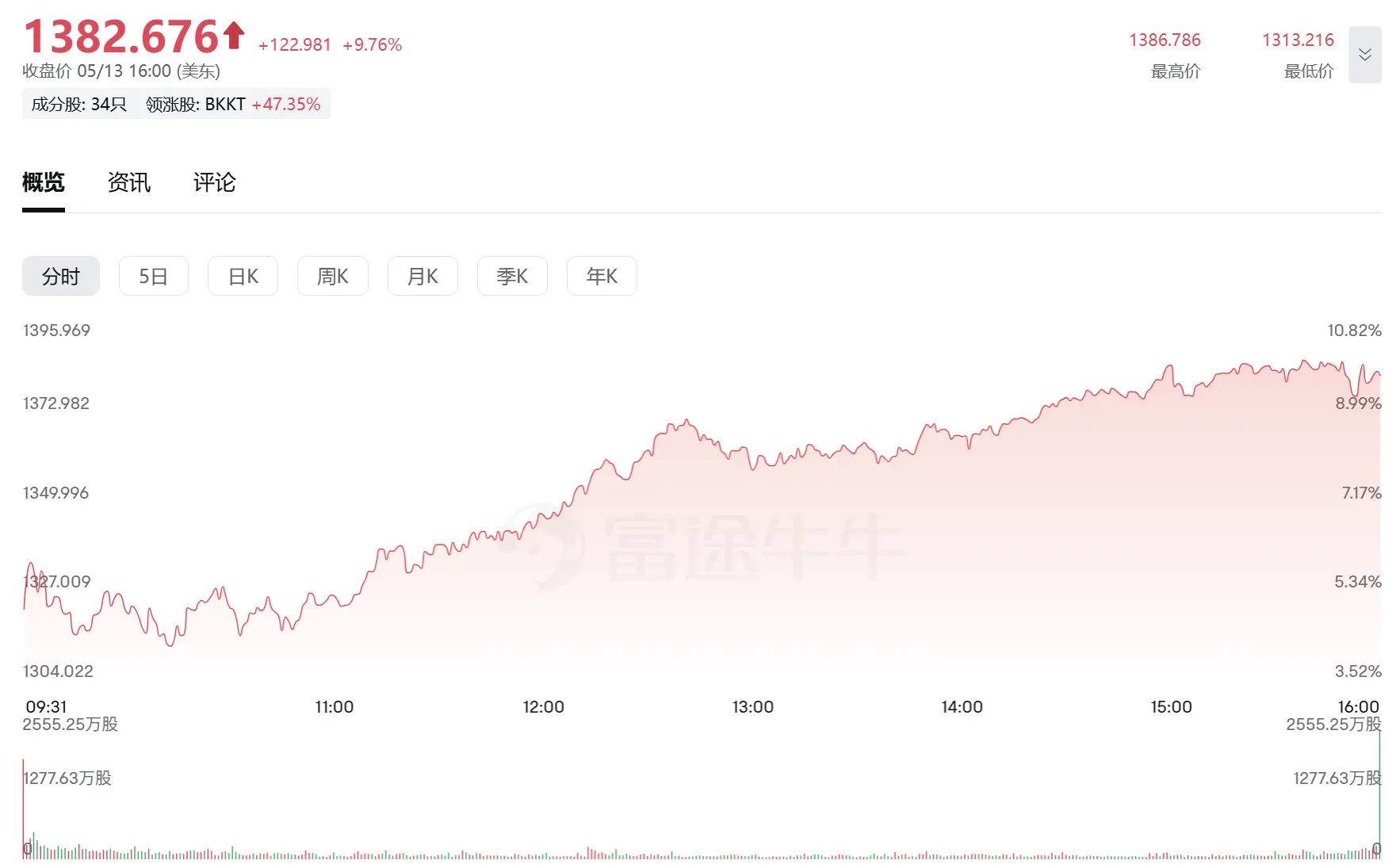Without any preheating or significant positive news, the crypto concept stock Bakkt surged over 50% overnight.
Not long ago, Bakkt was marginalized by the market due to customer loss and declining revenue, but it suddenly surged into the spotlight, becoming the most eye-catching presence among crypto stocks. What rhythm did this seemingly coincidental surge hit? Is it a short-term speculative game, or a signal of a quiet shift in industry trends?
Is Bakkt's Surge an Opportunity or Emotion?
On May 13, Bakkt's stock price surged over 50% in a short period. This company, once seen as a "bridge for traditional finance to enter the crypto world," has faced customer loss and shrinking revenue in recent years. This sudden reversal has attracted market attention. The superficial reason is that it achieved a net profit of $7.7 million in the first quarter, marking its first profit in years. However, a closer look at the financial report reveals that this was mainly due to cost reductions and one-time adjustments, with no significant improvement in core business.
What truly ignited the sentiment was the company's announcement of a new strategy. Bakkt announced a partnership with DTR, founded by a former SoftBank executive, to launch AI plugins and stablecoin payment services, entering the popular "PayFi" track—combining AI agents with on-chain settlement for global payment infrastructure. This new narrative of combining AI and crypto quickly sparked market speculation.
Additionally, Bakkt's "merger and acquisition concept" has been reactivated. Although previous acquisition negotiations with Trump's TMTG did not succeed, ICE still holds more than half of its shares, and there are rumors that Apex Fintech may take over. With a very small circulating supply and a short interest ratio as high as 23%, a short squeeze quickly unfolded, rapidly driving up the stock price.

From a fundamental perspective, the platform still faces significant pressure. On one hand, Bakkt's major client, the Nasdaq-listed brokerage Webull, will terminate its partnership in June. Bakkt previously provided cryptocurrency trading and custody services for Webull, which accounted for over 70% of Bakkt's total revenue. On the other hand, Bank of America will also end its partnership with Bakkt, affecting Bakkt's loyalty service segment, which primarily provides solutions for points redemption and digital rewards to corporate clients.
With the loss of these two major clients, Bakkt's revenue structure has become more fragile. This surge appears more like a concentrated release of short-term market sentiment rather than a substantial turning point in fundamentals.
Crypto Stocks in Collective Excitement: What is the Market Betting On?
Bakkt's unusual movement is not an isolated phenomenon. During the same period, the crypto concept stock sector generally strengthened, with several individual stocks showing significant gains. Coinbase rose by 23.97%, TeraWulf by 10.06%, Amber Group and DMG Blockchain by nearly 10%, and MicroStrategy also saw a rebound of over 4%. Overall, the crypto stock sector had a weekly increase of nearly 10%, indicating a concentrated investment in this area.

However, more importantly, the market is beginning to reassess the value of crypto "infrastructure." In previous cycles of the crypto market, most funds flowed into exchanges, platform tokens, or mining companies, but now investors are gradually turning their attention to "pipeline" companies—those providing custody, settlement, clearing, compliance, and risk control services. They resemble the utilities of this ecosystem, with stable revenue models and easier adaptability to traditional financial valuation systems. Bakkt's surge has precisely tapped into this structural preference, and it is not the only one.
Traditional Finance is Fully Entering the Game
The real turning point for the crypto industry is not the short-term rise in the stock price of a particular platform, but the increasing number of traditional financial institutions choosing to join this game.
Internet brokerages in Hong Kong have taken the lead. Futu Securities has launched cryptocurrency trading services, allowing users to recharge and trade mainstream cryptocurrencies like Bitcoin, Ethereum, and USDT directly through their Hong Kong and U.S. stock accounts; Tiger Brokers has introduced features for depositing, trading, and withdrawing crypto assets, integrating them with traditional stock trading; Victory Securities has also obtained a license to support crypto asset-related businesses, leading the market. Standard Chartered Bank's Hong Kong subsidiary has announced participation in the Hong Kong Monetary Authority's stablecoin sandbox with partners, attempting to explore on-chain payment solutions within a compliant framework.
At the same time, global payment giants are taking even more aggressive actions. Stripe has launched stablecoin accounts and the programmable stablecoin USDB, offering services in 101 countries; Visa and Mastercard are expanding their integration with partners like Circle, incorporating stablecoins like USDC into their payment networks, allowing users to consume on-chain assets through traditional cards; PayPal is attracting users to hold PYUSD with a 3.7% yield, attempting to build a settlement closed loop based on stablecoins. Even established cross-border remittance companies like MoneyGram are connecting traditional cash and on-chain assets through stablecoin "Ramps," covering over 170 countries.
The common direction of these movements is that traditional finance no longer views crypto as a threat but is beginning to actively "go on-chain." This is both a response to changing user demands and a pursuit of cost efficiency. Compared to the high fees and slow settlements of traditional networks, stablecoins and blockchain technology offer a faster, cheaper, and more transparent infrastructure. Those who can establish a foothold in this new system are more likely to retain their voice on the future financial map.
Bakkt's new strategy is a result of this trend. Although it may not match giants like Stripe and Visa in scale and technology, as an institution holding a full U.S. license with custody and clearing capabilities, it still has the potential to become a target for mergers or a gateway for partnerships. This is why the market is re-evaluating it—not for how much it earned today, but for its potential to become the next ticket to entry.
Conclusion
Bakkt's surge is a microcosm of this wave of market activity, but it is not the whole picture. As the capital market begins to reassess the value of crypto infrastructure, and more traditional financial institutions no longer shy away from crypto technology, "on-chain finance" is becoming an executable strategy rather than a distant fantasy. We are witnessing the beginning of a shift in an era.
This round is not about those who shout slogans for hype making money, but about those who truly build bridges, pave roads, and connect to mainstream systems leaving value.
免责声明:本文章仅代表作者个人观点,不代表本平台的立场和观点。本文章仅供信息分享,不构成对任何人的任何投资建议。用户与作者之间的任何争议,与本平台无关。如网页中刊载的文章或图片涉及侵权,请提供相关的权利证明和身份证明发送邮件到support@aicoin.com,本平台相关工作人员将会进行核查。



